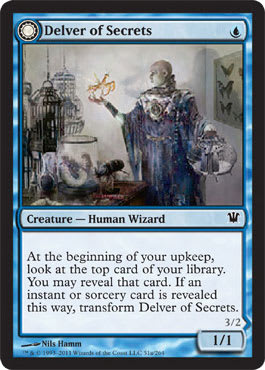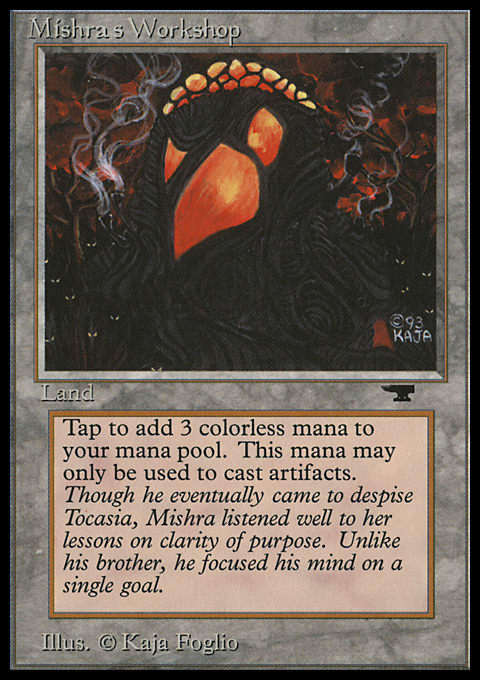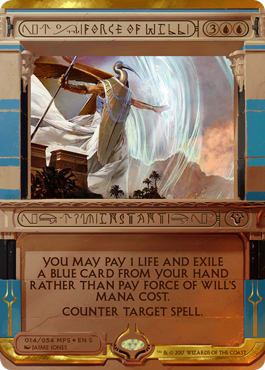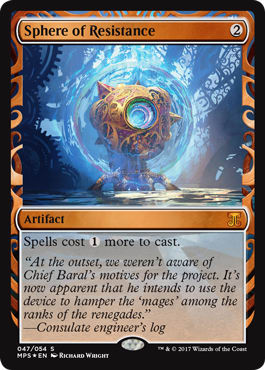Currently, there are three significant sources of metagame information for Vintage Magic: The Gathering: Magic Online results, which have small events and show a limited number of top-finishing decks; the four-hundred-sixty-two-player Vintage Championship results, which is the clearest, largest snapshot of the format we’ve ever had; and the paper tournament results from various locations in the U.S., Europe, Australia, Japan, and elsewhere. However, there are concerns with any of these data sources, risks with relying on them too closely, even as an amalgam.
Kevin Cron and Stephen Menendian did an extensive review of the MTGO Vintage metagame on their So Many Insane Plays podcast before Champs. They accurately noted the prominent presence of Delver (especially U/R and Grixis) and various Mishra's Workshop builds, but they warned that things like Worldgorger Dragon and Bomberman aren’t fairly represented because their recursive, “infinite” combos can’t be replicated using the online software.
They also noted that the Workshop metagame results showed a large number of higher finishes by Montolio, one player in particular. That could indicate that Monolio himself is good enough to skew those results on his own—or it could simply indicate that Workshops is the best deck in the format and Montolio just happens to play it.
Cron and Menendian also suggested that the Workshops-versus-Delver online environment may be evidence of a somewhat immature, budding Vintage metagame. Of course, there are skilled and experienced players, but the ready availability of online Power and opponents has made the format accessible and attractive for new players as well. Many of these newer players will have come from Legacy and Modern, so Delver will be a comfortable first deck choice. They may also lack experience playing against Workshop, missing some of the skills for building a solid mana base, navigating various lock pieces, or selecting and applying hate cards.
Toward the end of their podcast, after all of this analysis, Cron and Menendian predicted an Oath of Druids deck wouldn’t win Vintage Champs 2015. Of course, Brian Kelly had to prove them wrong, which they acknowledged in a follow-up podcast.
When it comes to the Champs results, the simple act of bringing four hundred or more Vintage players to one location at one time is a huge step forward for the format. The problem still, ultimately, is that it’s just one event. The number of games and matches played is great, but there are so many things that could have turned out differently over ten rounds.
Another problem with Champs is that it’s a sanctioned, non-proxy event—players might not be able to acquire all the cards they would need to play their decks of choice. Workshop decks were perceived by many as the best in the format going into the event, but they’re also expensive and difficult to find!
.@wizards_magic Vintage Champs 2015 featured approximately 1.3% of all Mishra's Workshops *ever printed*.
cc @mtgaaron
— Kevin Noël Cron (@kevincron) September 5, 2015
Workshop players are on the hook not only for the usual five Moxes and Black Lotus, but also play sets of Mishra's Workshops and Wastelands among other things. For all the Workshop decks that were played in Philadelphia (one hundred in all), there could have been even more if Mishra's Workshop weren’t pushing $1,000 and Power were more available. Comparatively, other decks, such as Delver, Landstill, and Dredge—still good decks, with different ways to attack the format—would have been more affordable and may have been more represented than in an environment with “perfect” availability.
For local paper tournaments, the problems are similar to those on MTGO. Cards are readily available, especially in proxy metagames (like most of those in the U.S.), so there’s little worry of a player using a deck he or she doesn’t think is the best at the time. The bigger issue is that local tournaments are, for the most part, small. They become inbred as players gain reputations for playing particular cards, decks, or archetypes. I can say, for example that Ohio in general is weak against Dredge; we have one regular Dredge player, so many of our regulars run the gambit of reducing or forgoing graveyard hate, hoping to not face him or hoping other players knock him out.
Many local events are under thirty-two players—that is, just five rounds before cutting to Top 8. There’s some question of a deck’s tournament performance when a round-one bye, two real wins, and a couple of intentional draws lead to a Top 8 berth and perhaps a prize split. Smaller events might not even necessitate that second win. The pride of making Top 8 at an eighteen-player event notwithstanding, these events aren’t exactly crucibles for figuring out format contenders.
So we’re left with a pile of data from various sources, each of which has some flaws that make it difficult to rely on individually and equally difficult to combine. If you play only online, for example, you may choose to deemphasize the local metagame results, and vice versa if you play only in paper. And how do you weigh the one-time Champs results with smaller tournament results from one or two or five months ago? The Champs results themselves are influenced by previous, recent events, too, as players were brewing, tweaking, and testing with the larger event in mind.
We’re Richard Dreyfus left with a mashed potato pile of available information: This means something. This is important.

Thankfully, Jason Jaco at Eternal Central did a huge amount of valuable work, going through decklists, categorizing them, and collecting additional information. Definitely give that site a visit; I recommend the lists of videos and tournament reports at the bottom especially.
Looking at the “Decks, by Archetype” graph at EC, there aren’t a lot of surprises. The numbers of each type—broadly grouping Force of Will, Workshop, Dredge, Other, and Combo—is about what would be expected from the Vintage as a whole. Slightly more than half the tournament played Force of Wills (260 out of 462, 56%); this includes everything from very aggressive combo to budget-oriented, creature-based decks like Merfolk. I probably would have categorized the combo decks (like the Belcher Mono-Blue I played and Danny Batterman’s innovative Belcher G/U and “Every City Vault”) separately, but their numbers aren’t extensive and wouldn’t shift things significantly. The numbers suggest, however, that most players felt that blue-based decks, starting with Force of Will, were still the best way to attack the format. And, indeed, the two finalists came from this group.
The number of Workshop decks as a whole is also not alarming. I usually plan (based on experience) on artifact decks falling between 20% and 25%, and their one hundred players at Champs make up a reasonable 22%. These are further broken down into ten general types, including Mono-Blue and the Mono-Red. Interestingly, the most-played individual archetype was Workshop Forgemasters (55 players, 12% by themselves), but it was the new Hangarback Aggro lists that finished highest, placing two in the Top 8, piloted by Rich Shay and Paul Mastriano.
Looking deeper, Workshops in general also outperformed their numbers. Typically in a large event like Champs, we should expect that a deck’s appearance percentages should hold across smaller subsections; that is, if 10% of players play Deck X, around 10% of the Top 64 or Top 32 should also be Deck X. At Champs, Workshops as a group made up 22% of the field, but they were 34% of the Top 64 and Top 32. That’s a 12% increase toward the winning end of the field—good for them, but perhaps dangerous implications for the health of the format. Perhaps the Workshop group is moving from “good” to “too good.”
I’m generally conservative when it comes to restrictions, especially with artifacts. Remember we’re looking at 22% Workshops versus 56% Force of Wills, and it was still a blue finals. There are plenty of reasons Workshops would rise to the top without being a problem. For example, Workshops are, by necessity, not going to be budget decks, and budget decks (as evidenced by the ranks on Eternal Central) tend to fall toward the bottom, making more room at the top.
A related effect is that Workshop players are going to tend to be more invested in the format; they will tend to have more experience with the format. Along with playing an inherently powerful, consistent deck, that experience will lead to more wins. Adding to this was that some of Vintage’s best blue players, like Paul Mastriano and Rich Shay who made Top 8, and Brian Demars who made Top 16, were on artifacts for Champs but could have finished well regardless of deck choice.
So, my feeling is still that Workshops in Vintage are okay—no restrictions necessary. They perhaps need watching, but the blue decks can adjust to beat them. As I pointed out in my last article, many of the high-placing blue decks at Champs were running at least twenty-four mana sources (lands and artifacts) in the main deck, often with more available post-’board. Strong mana is critical to beating Workshops because it allows you to cast your spells against Wastelands and Sphere of Resistance effects. Unfortunately against more aggressive blue decks, for those running fewer mana sources and a lot of draw spells like Gush, too much mana might mean falling behind and losing the game to card advantage.
The metagame might be settling into a familiar rock-scissors-paper pattern. Here, Workshops beat Gush decks; Gush decks beat big-mana blue decks; and big-mana blue decks beat Workshops. Dredge acts as a wildcard, beating any deck that tries to gain an edge against its foil, and Hate and Combo decks are there, trying to outguess or ignore opponents, respectively, as usual.
So what should you play in Vintage if you’re looking to get ahead in this environment? What strategies give an edge without necessarily falling victim to the rest of the format’s plans against the top decks? I have three options in mind, two from the Saturday trial at Champs.
B/U/G Control ? Vintage | Jimmy McCarthy
- Creatures (12)
- 1 Notion Thief
- 2 Trygon Predator
- 3 Snapcaster Mage
- 4 Deathrite Shaman
- 2 Tasigur, the Golden Fang
- Planeswalkers (2)
- 2 Jace, the Mind Sculptor
- Spells (28)
- 1 Ancestral Recall
- 1 Brainstorm
- 1 Flusterstorm
- 1 Misdirection
- 2 Thought Scour
- 3 Abrupt Decay
- 3 Dig Through Time
- 3 Mental Misstep
- 4 Force of Will
- 1 Demonic Tutor
- 1 Ponder
- 1 Time Walk
- 1 Treasure Cruise
- 1 Black Lotus
- 1 Crucible of Worlds
- 1 Mox Emerald
- 1 Mox Jet
- 1 Mox Sapphire
- Lands (18)
- 1 Swamp
- 1 Bayou
- 1 Misty Rainforest
- 1 Polluted Delta
- 1 Strip Mine
- 2 Tropical Island
- 3 Underground Sea
- 4 Verdant Catacombs
- 4 Wasteland
- Sideboard (15)
- 1 Dismember
- 1 Snuff Out
- 1 Energy Flux
- 1 Forest
- 3 Nature's Claim
- 1 Null Rod
- 1 Abrupt Decay
- 1 Engineered Explosives
- 1 Virulent Plague
- 1 Ravenous trap
- 3 Grafdigger's Cage
Jimmy McCarthy took third at the Saturday trial with this Swiss Army knife of a B/U/G Control list. There is a lot to like here, starting with six powerful delve spells and three Snapcaster Mages as well as two Thought Scours to fuel them. Against Workshops, this deck features twenty-two mana sources (including Wastelands) plus four Deathrite Shamans, which pull double-duty against opposing Dredge decks and delve spells. Abrupt Decays deal broadly with many of the format’s threats, but main-decked Trygon Predator and Notion Thief can be devastating against their particular targets. Post-’board, a variety of strong cards are as difficult to predict as they are to play against.
Worldgorger Dragon Combo ? Vintage | J.R. Goldberg
- Creatures (7)
- 3 Worldgorger Dragon
- 1 Tasigur, the Golden Fang
- 3 Jace, Vryn's Prodigy
- Spells (35)
- 1 Ancestral Recall
- 1 Vampiric Tutor
- 2 Dig Through Time
- 2 Hurkyl's Recall
- 2 Intuition
- 2 Mental Misstep
- 4 Force of Will
- 1 Demonic Tutor
- 1 Time Walk
- 1 Timetwister
- 1 Treasure Cruise
- 2 Gitaxian Probe
- 2 Thoughtseize
- 1 Dance of the Dead
- 1 Necromancy
- 3 Animate Dead
- 1 Black Lotus
- 1 Mana Crypt
- 1 Mox Emerald
- 1 Mox Jet
- 1 Mox Pearl
- 1 Mox Ruby
- 1 Mox Sapphire
- 1 Sol Ring
- Lands (18)
- 1 Swamp
- 2 Island
- 1 Tundra
- 3 Polluted Delta
- 3 Underground Sea
- 4 Bazaar of Baghdad
- 4 Flooded Strand
- Sideboard (15)
- 1 Plains
- 2 Cavern of Souls
- 1 Auriok Salvagers
- 2 Monastery Mentor
- 1 Nihil Spellbomb
- 2 Steel Sabotage
- 3 Containment Priest
- 1 Serenity
- 1 Tasigur, the Golden Fang
- 1 Flusterstorm
It may seem surprising that a Worldgorger Dragon Combo list can exist in a format with so much graveyard hate for Dredge, but that’s partly the key to its success. In Game 1, it can win quickly, before Workshop lock pieces become a problem or the Gush draw engine can start finding answers. Bazaar of Baghdad has always held the combo together, but Dig Through Time and Jace, Vryn's Prodigy, complement the strategy nicely. Post-’board, depending on the matchup, J.R. Goldberg’s list (which he credits to Matt Murray in a report) can skip the graveyard entirely and play Mentor Control, with Bomberman combo available if graveyard hate doesn’t materialize.
Academy Combo ? Vintage | Hrishikesh Sidhartha
- Planeswalkers (3)
- 1 Tezzeret the Seeker
- 2 Dack Fayden
- Spells (44)
- 1 Ancestral Recall
- 1 Vampiric Tutor
- 2 Stroke of Genius
- 4 Force of Will
- 1 Demonic Tutor
- 1 Ponder
- 1 Time Walk
- 1 Timetwister
- 1 Wheel of Fortune
- 4 Thoughtcast
- 4 Time Spiral
- 1 Mind Over Matter
- 1 Black Lotus
- 1 Mana Crypt
- 1 Mana Vault
- 1 Mox Emerald
- 1 Mox Jet
- 1 Mox Pearl
- 1 Mox Ruby
- 1 Mox Sapphire
- 1 Sol Ring
- 1 Time Vault
- 1 Voltaic Key
- 2 Defense Grid
- 3 Sensei's Divining Top
- 4 Expedition Map
- 2 Mox Opal
- Lands (13)
- 1 Polluted Delta
- 1 Underground Sea
- 2 Volcanic Island
- 4 Scalding Tarn
- 1 Minamo, School at Water's Edge
- 1 Tolarian Academy
- 3 Seat of the Synod
- Sideboard (15)
- 1 Mountain
- 4 Ingot Chewer
- 2 Viashino Heretic
- 1 Pithing Needle
- 2 Grafdigger's Cage
- 2 Tormod's Crypt
- 1 Yixlid Jailer
- 1 Toxic Deluge
- 1 Defense Grid
As a rule in Vintage, if everything else is up in the air, having more broken cards will bail you out of some bad situations. Again, fast combo should be good to sneak under most blue decks’ countermagic, and strong mana helps push through Workshops. This list, which Hrishi Sidhartha played to 131st at Champs, has both of those things. It’s similar to the lists Eternal Central names Every City Vault, except that it emphasizes Tolarian Academy, with a play set of Expedition Maps to find it. That’s an idea worth exploring, and Sidhartha wrote a development report that looks into some of his choices. My favorite is the one-of Minamo, School at Water's Edge!
Vintage will be in an interesting place for a while as players adjust to the knowledge gained at Champs. Workshop decks should remain a popular deck to beat, while blue players decide whether big mana or a lot of draw spells are the better way to win. It’s also appearing that Workshops will receive some much-needed definition as lists break into those with different strategies based on combinations of Kuldotha Forgemaster, Hangarback Walker, Metalworker, and Smokestack, deciding which works best against expected opponents. There are some good opportunities for innovation as the dust settles.
Thanks for reading!
Nat Moes




























